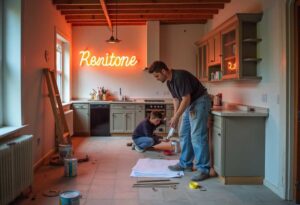Expanding your living space through a home addition is one of the smartest investments homeowners can make. Whether it’s to accommodate a growing family, enhance comfort, or increase property value, well-planned additions can transform how a home functions and feels. In today’s remodeling landscape, there’s a rising demand for designs that balance luxury, practicality, and long-term appeal.
This comprehensive guide will explore innovative home addition ideas tailored to modern lifestyles. You’ll discover design strategies, layout considerations, and important factors to keep in mind when planning your project. Whether you envision a sunroom retreat, a spacious family room, or a fully equipped guest suite, this article offers valuable insights to help you expand your living space intelligently and beautifully.
Introduction to Modern Home Additions
Home additions are no longer just about gaining extra square footage; they are about reimagining how we live. In today’s world, homeowners seek spaces that enhance lifestyle, boost property value, and create lasting comfort. With thoughtful planning, a home addition can transform your home’s functionality without sacrificing style.
In this guide, you’ll discover a range of modern home addition ideas designed to maximize space, style, and convenience. Whether you’re planning a cozy sunroom or an impressive second-story expansion, this resource will help you navigate the possibilities smartly.
Quote:“A house is made with walls and beams; a home is built with love and dreams.” — Ralph Waldo Emerson
Key Trends Driving Home Expansions in 2025
Home expansion trends in 2025 focus on adaptability, sustainability, and technology integration. The pandemic-era focus on functional living spaces continues to influence design priorities.
Key trends include:
- Multi-purpose rooms: Spaces that adapt to different needs, like hybrid offices/guest rooms.
- Sustainable materials: Eco-conscious designs featuring recycled wood, low-VOC paints, and energy-efficient windows.
- Smart technology: Integrated systems for lighting, security, and climate control.
- Indoor-outdoor flow: Bi-fold doors and patios that extend living spaces into nature.
Pro Tip:When planning your addition, think about future-proofing your design. What fits your lifestyle today should also serve you five or ten years from now.
Space Planning: Maximizing Every Inch
Strategic space planning is essential to a successful home addition. Poorly designed expansions can feel disconnected or cramped, while smart designs enhance flow and functionality.
Top considerations for smart space planning:
- Function first: Identify the primary purpose of the addition before choosing a design.
- Natural light: Prioritize windows, skylights, and open layouts to create bright, welcoming spaces.
- Traffic flow: Ensure the new space connects seamlessly to existing rooms.
- Ceiling height: Higher ceilings can make smaller additions feel much larger.
Luxury Master Bedroom Additions
Adding a luxurious master suite is one of the most rewarding upgrades for homeowners. A spacious, thoughtfully designed bedroom can offer a true retreat while significantly boosting resale value.
Essential elements for a master suite addition:
- Walk-in closet: A must-have feature for modern luxury.
- Spa-style bathroom: Freestanding tubs, rain showers, and double vanities elevate comfort.
- Private sitting area: Perfect for unwinding at the end of the day.
- Direct outdoor access: French doors leading to a patio or garden add an extra layer of luxury.
Pro Tip:Consider placing the new master suite in a quieter part of the house, away from high-traffic zones for maximum tranquility.
Bright and Airy Sunrooms
Sunrooms continue to rise in popularity for homeowners looking to blend indoor comfort with the beauty of the outdoors. In 2025, sunroom additions are designed for year-round use with advanced insulation, temperature control, and UV-protective glass.
Features to incorporate in your sunroom:
- Full-glass walls or floor-to-ceiling windows
- Operable skylights for ventilation
- Insulated flooring and weather-resistant finishes
- Flexible furnishing for reading, lounging, or even casual dining
Quote:“Sunlight is the best disinfectant — and the best design element.” — Louis Sullivan
Kitchen Bump-Outs for Gourmet Cooking
The kitchen is often the heart of the home, and expanding it can dramatically enhance daily living and entertaining. A kitchen bump-out is a small-scale addition that can create room for an oversized island, a breakfast nook, or expanded cabinetry.
Popular ideas for kitchen bump-outs:
- Add a butler’s pantry for extra storage and meal prep space.
- Incorporate large windows to flood the area with natural light.
- Create a dining alcove that feels cozy yet open.
- Upgrade to commercial-grade appliances to transform cooking into a gourmet experience.
Pro Tip:When planning a kitchen bump-out, focus on traffic flow and counter space to maximize both form and function.
Second-Story Additions for Vertical Growth
When lot space is limited, building upward is a smart way to gain living space without sacrificing your yard or outdoor areas. A second-story addition can nearly double your home’s size and functionality.
Key benefits of a second-story addition:
- Additional bedrooms and bathrooms without expanding the footprint
- Spectacular views from newly elevated spaces
- Enhanced property value by adding square footage
- Flexible floor plan options for private retreats or open-concept designs
Quote:“Architecture should speak of its time and place, but yearn for timelessness.” — Frank Gehry
Family Game Rooms and Entertainment Zones
Dedicated family spaces are becoming essential as homeowners seek ways to bring entertainment home. A new addition designed as a game room, theater space, or general family lounge offers year-round fun without leaving the house.
Ideas for entertainment-focused additions:
- Home theaters with soundproofing and tiered seating
- Multi-game setups featuring pool tables, foosball, and board game centers
- Media walls with integrated sound systems
- Snack bars or small kitchenettes for movie nights and parties
Pro Tip:Soundproof walls and floors are crucial if your game room is adjacent to bedrooms or quiet zones.
Home Gyms and Wellness Retreats
Wellness-focused spaces are on the rise, and adding a private gym or relaxation room can transform your health and daily routine. These spaces promote self-care without the need for travel.
Must-have features for a wellness addition:
- Rubberized or cork flooring for safe workouts
- Mirrored walls to track form and technique
- Sauna or steam room installations for post-workout recovery
- Large windows or glass doors to invite natural light and calming views
Quote:“Take care of your body. It’s the only place you have to live.” — Jim Rohn
Smart Home Additions: Integrating Technology
Modern additions increasingly prioritize integrated smart home technology. Automation brings convenience, energy efficiency, and enhanced security to every new space.
Smart tech features to incorporate:
- Automated blinds and lighting to create the perfect atmosphere
- Voice-controlled climate systems for optimal comfort
- High-speed wired internet for seamless connectivity
- Security systems with smart locks and video monitoring
Pro Tip:Plan your wiring and tech integration during the early design phase to avoid costly retrofits later.
Multi-Generational Living Spaces
As more families choose multi-generational living, designing self-contained spaces within the home is increasingly popular. Additions that accommodate parents, adult children, or long-term guests create both independence and closeness under one roof.
Key features for multi-generational spaces:
- Private entrance for added autonomy
- Dedicated kitchenettes and bathrooms
- Flexible layouts that allow for both privacy and connection
- Soundproofing and accessible design elements for long-term comfort
Pro Tip:Always design with accessibility in mind—wider doorways, step-free showers, and grab bars are small investments with big future value.
Outdoor Kitchens and Covered Patios
Outdoor living is no longer an afterthought; it’s an extension of the home. Building an outdoor kitchen or covered patio creates new opportunities for dining, entertaining, and relaxation.
Essentials for a luxurious outdoor living space:
- Weather-resistant cabinetry and countertops
- Built-in grills, pizza ovens, and mini-fridges
- Overhead fans and heaters for year-round comfort
- Retractable awnings or pergolas for flexible shade
Quote:“There’s no Wi-Fi in the garden, but the connection is better.” — Unknown
Garage Conversions: From Storage to Living Space
Transforming a garage into usable living space is a highly cost-effective addition option. Whether it becomes a guest suite, a home office, or a personal gym, garage conversions maximize your property’s footprint without expanding it.
Popular uses for garage conversions:
- Private studios or home offices
- Guest bedrooms with en-suite baths
- Game rooms or teen lounges
- Home fitness spaces
Pro Tip:Always insulate and finish walls properly when converting a garage to ensure year-round comfort and energy efficiency.
Sustainable Materials and Eco-Friendly Additions
Sustainability is at the forefront of modern remodeling, and using eco-friendly materials benefits both the environment and your home’s energy costs.
Best sustainable choices for home additions:
- Bamboo flooring for a fast-renewing, beautiful material
- Low-VOC paints and finishes to maintain healthy indoor air quality
- Energy-efficient windows and doors to minimize heat loss
- Solar panels integrated into new roof structures
Quote:“Sustainability is no longer about doing less harm. It’s about doing more good.” — Jochen Zeitz
Navigating Permits and Zoning for Additions
Before breaking ground, it’s critical to understand your local zoning laws and permitting requirements. Failure to secure proper approvals can lead to costly delays—or worse, forced removals.
Important permit and zoning considerations:
- Setback requirements: How close you can build to property lines
- Height restrictions: Particularly for second-story additions
- Utility easements: Areas you must leave unobstructed
- Historic district rules: If your home is under special protections
Pro Tip:Always work with an experienced contractor or architect who understands your city’s regulations and can guide the permitting process smoothly.
FAQs About Expanding Your Living Space
What is the most cost-effective type of home addition?
Garage conversions are often the most affordable, followed by simple bump-outs or small sunroom additions.
Do I need a permit for every home addition?
Almost always, yes. Building codes usually require permits for any addition that alters the structure, plumbing, or electrical systems.
How do I make a home addition match my existing house?
Focus on matching roofing, siding, window styles, and trim details for seamless integration.
How much value can a home addition add to my property?
Depending on the type and quality of the addition, homeowners typically see returns between 50% to 80% of the project’s cost in home value.
What's the timeline for building a home addition?
Simple bump-outs can take 2–3 months, while full second-story additions might require 6 months or more, depending on complexity.





